Figure 2.
Schematic of the developmental process of colour pattern formation and how this relates to the four reliability mechanisms discussed in §3. A melanin-based pattern expressed in a plumage trait has been selected as an illustrative example, although the general scheme can be easily translated to other types of traits (skin-, hair- or scale-based). Pattern expression depends on the developmental control of processes that take place at different scales and that require a tight spatio-temporal coordination. These include, for instance, the arrangement during early embryonic development of structural units (feather germs) and pigmentary cell precursors (melanocytes) across the body according to the general pattern layout (i). During structural unit growth, the topology and maturation of undifferentiated (white circles) into differentiated melanocytes (black symbols) must be coordinated with structural unit growth (ii). A correct synchronization between melanosome production by differentiated melanocytes and their transfer to proliferating keratinocytes is required to elaborate the within-unit pattern adequately (iii). Furthermore, these structural units must be developed, arranged and perfectly imbricated to fully display the composite pattern resulting from their combined effect (iv). Stressors altering all these steps will exert cumulative effects on the final pattern, which would be gradually deviated from its optimum. Individual capacity to buffer such deleterious effects will differ among high- and low-quality individuals, making colour pattern expression a reliable index of developmental homeostasis (§3b). Beyond these factors affecting pattern development, individual wearing an undamaged, immaculate and well-groomed plumage, coat or skin will be able to better display their colour pattern (v), which would then act as an amplifier of somatic integrity (§3c) and investment on maintenance activities (§3d). Finally, overall pattern appearance would elicit variable responses from conspecifics, mediating the reliability of colour pattern features as conventional signals of status (§3a). (Online version in colour.)

